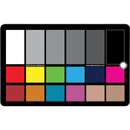Most folks, no matter how educated, do not have any grasp of the somewhat obscure way that light and color and the human visual perceptive system work. They mistake cyan for blue and magenta for red, and while a printer can use "black" ink, to a photographer black is simply not a color, it is an absence of color. So it all gets a little complicated.
For instance, the human eye cannot see the color yellow. We only have sensors for red, green, and blue. Our brains "deduce" or perhaps "guess" there is yellow, by the imbalance mainly of blue and green. What you see as "lemon" yellow, as a color, may be very different from what I see. We both know "that's a lemon" but really, what do we think we're seeing?
There is logic and science behind it all, but SO much misinformation, or crossed information, or simply questions of context. Like, whether black or white are colors.(G)
Not to mention, what was it, last year? The news kerfuffle about whether a dress was blue or gold? And viewers of the same image couldn't agree on it? That's our perception system getting the facts all out of kilter again.




